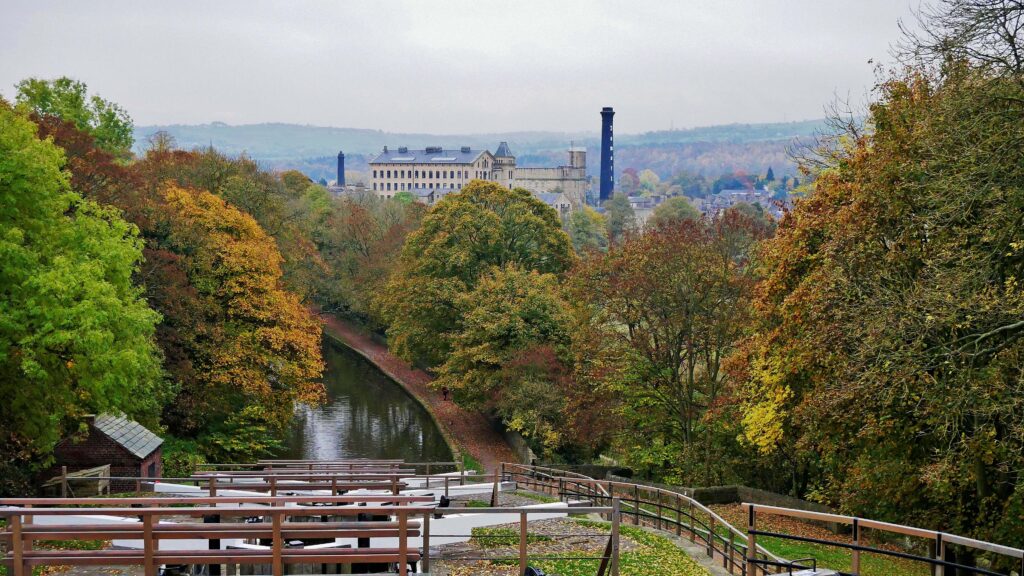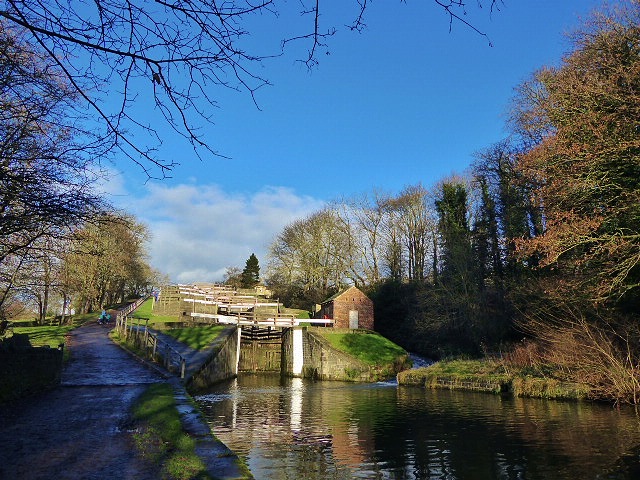Welcome to Bingley
The old Saxon town of Bingley is very pleasantly situated in the valley of the Aire about twelve miles from Leeds and six miles from Bradford. At one time consisted of but a few houses, clustered around its venerable Parish Church, the little place lay deeply en bosomed amidst high craggy hills and embowering woodlands, and well did it deserve its title of “The Throstle Nest of Old England” which it still fondly bears. Harry Speight, Chronicles and stories of Old Bingley 1898
A Brief History

Bingley is situated on the North-East side of the river Aire, where two side valleys join the main valley. It is sited on the glacial moraine which stretches across the valley. Overlooking the valley in the North are Rombalds Moor and Gilstead Moor, and from the South West are Harden Moor, Cottingley Moor and Noon Nick a glacial overflow channel from Bradford. The two side valleys are the Morton/Micklethwaite on the North and the Harden Valley to the South. After the Ice Age, the glacial floods converted the area now known as Bailey Hills into an island. Since then the area is known as Bailey Hills and Castlefields.
There is no real evidence that there ever was a castle here, however an old 1592 map of the Keighley Road was Castle Layne, and another 1762 map shows the land near the present cemetery on Bailey Hills is Great Castle Field and Middle Castle Field. On the top of the crag, North West of the town is Druids Altar it is not known if it ever was used by Druids however it faces the rising sun and commands a magnificent view up and down the valley below.
In the 1940s when people were digging for victory (cultivating the land to grow vegetables for the war effort), there were several lithics, stone tools, found in the fields behind Druids Altar. Among these were the cores of the tools which implied people were making the tools here, not just dropping them on the way past. There is a Stone Circle on Harden Moor. This was excavated in the latter part of the 20th century and a cremation urn was found, now on display in Cliff Castle Museum in Keighley. It is thought to have started as a timber ring which burnt down and was replaced by a Stone Circle before the final Ring Cairn constructed. It is the Early Bronze Age. Also on Harden Moor, there is mention of two Roman Roads which crossed it. One from Manchester to Ilkley, the other from Pontefract, Wakefield to Elslack.

Bingley is thought to have been founded in Saxon times, having a ford on the River Aire giving access to neighbouring villages south of the river. Since Bingley Church in early years was the only church in the area, so people came from all around to church on a Sunday to worship. It was granted a Market Charter in 1212 by King John enabling a weekly market to be held on a Sunday. This would have been held in the churchyard at that time. Bingley was granted a market charter before both Bradford and Keighley.
In 1753 it was moved to a Market Hall along with the Butter Cross and Stocks. The Stocks were last used in 1870 and it is believed they were the last to be used in Yorkshire. The Market, Butter Cross and Stocks were moved to Prince of Wales Park for several years. They are now back in the centre of the town just below the new Market Square, alongside the Bingley Arts Centre.
Before the building of Cottingley Bridge, the main way to Bingley from Bradford was down the hill to Cottingley and then following the river upstream to Beckfoot where the Pack Horse Bridge (built 1723), and ford still exist. The road left the river at this point following the present-day Beckfoot Lane to what is now Harden Road. The old road crossed Harden Road into Bell Bank Wood (now part of St Ives), it proceeded downhill in a hollow-way eventually reaching the ford across the river which later was replaced by a narrow wooden bridge only wide enough for a horse, this was replaced by a stone bridge in 1685 and widened even more in later years. Bingley was on a major coaching route from Leeds and Bradford to Kendal. It had three coaching inns, one of them still exists, the White Horse Inn which is the oldest Inn in Bingley.

Bingley with a population of about 20,000 people is near to a group of villages which have resisted being swallowed up into the town. These communities consist of Harden, Wilsden, Cullingworth, Harecroft, Morton, Micklethwaite and Rycroft. One of the attractions in Bingley is the Leeds Liverpool Canal. The section from the top of five rise locks to Skipton was opened in 1773, the 5 Rise, 3 Rise, 2 Rise and seven arches viaduct Hirst Wood were opened in 1774 and three years later it joined up to Leeds. It’s always a pleasure to walk along the canal.
There are two delightful parks in Bingley. Myrtle Park is in the centre of town along the riverside, often used to hold outside events as well as a children’s playground, skateboard area and bowling greens. Prince Of Wales Park is on the hillside north of the town heading towards Eldwick, there are lots of short woodland walks within the park.
Across the river, only half a mile up the hill is St Ives Country Park. This area is excellent for walking through woodland and more open spaces. There is a lake called Coppice Pond and a bird hide for observing wildlife. This area is steeped in history having been a monastic grange belonging to Rievaulx Abbey until about 1540.
Bingley has one of the oldest schools in the country, Bingley Grammar School. It was founded in the 16th century.
The Airedale Agricultural Show has been in operation since 1862, holding the annual one-day event in Myrtle Park.
The first Airedale Terrier was bred in Bingley, also known as the Bingley Terrier.
Bingley Arts Centre, the home of Bingley Little Theatre.
The Little Theatre was founded in 1947 and moved to the present site in 1974. The Little Theatre
puts on eight plays during the season and many and varied events are held in the Arts Centre.
Bingley Swimming Baths were opened by Princess Mary in 1927, also called Princess Hall.
Three well-known people of Bingley are: –
Fred Hoyle, Astronomer born in Bingley 1915 educated at Bingley Grammar School.
John Braine, author of Room at the Top. Worked in Bingley library until 1942.
Rodney Bewes, Actor famous for role as Bob Ferris in The Likely Lads, born in Bingley 1938.
For self-guided walks around the Bingley, area see the Bingley Walkers are Welcome web page.
The town has a variety of refreshment places as well as cafes in Myrtle Park, St Ives and Five Rise Locks.
Overnight accommodation is available at Premier Inn Crossflatts, Mercure Bankfield Hotel, Five Rise Locks Hotel and Oakwood Hall Hotel.
Public Transport.
Bingley has two railway stations, Bingley and Crossflatts.
Trains destined for Leeds, Bradford and Skipton and beyond pass through these stations.
Regular bus services to Keighley, Bradford and Leeds also pass through the town.